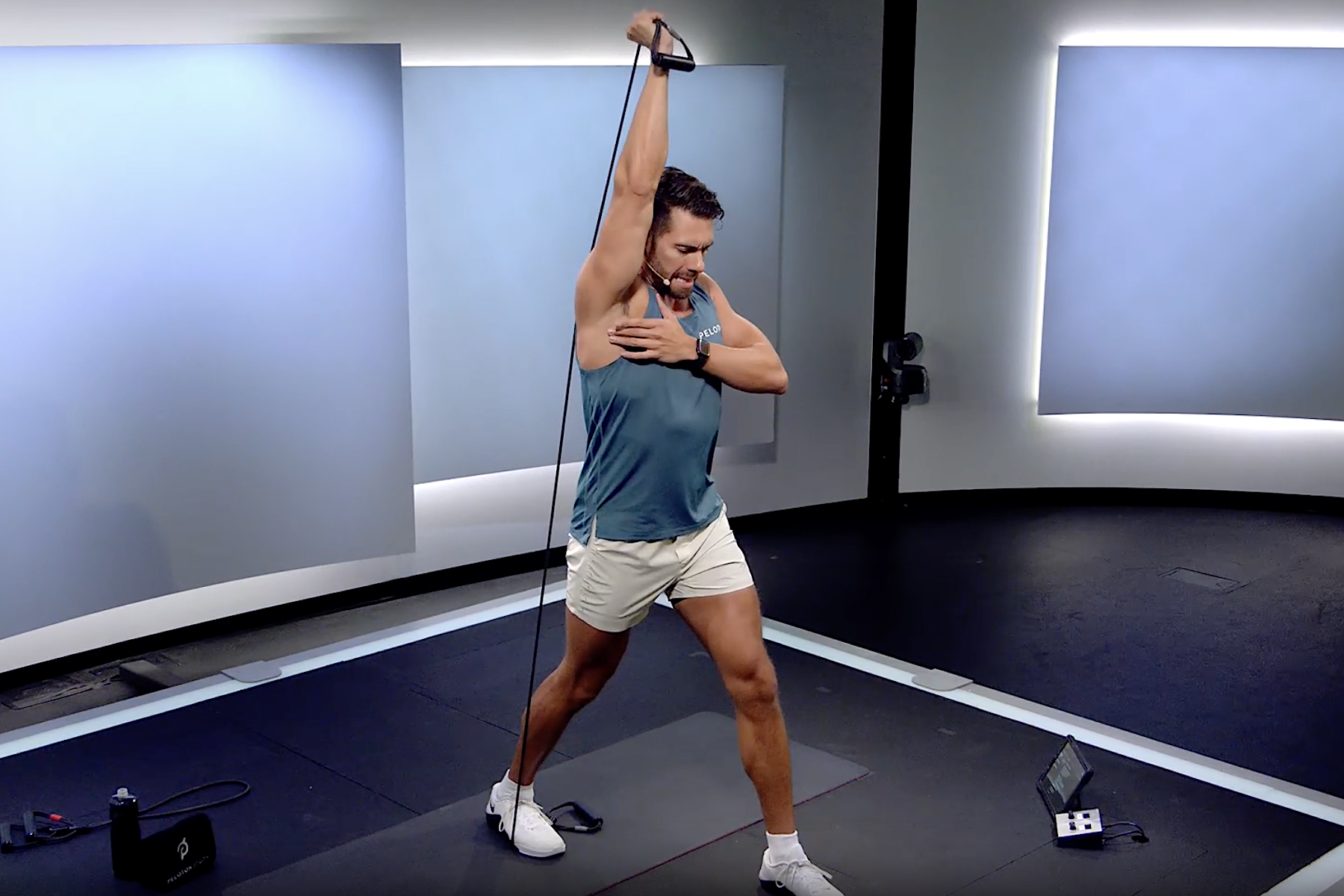
The 6 Best Resistance Band Moves for a Strong Upper Body
Resistance bands are an effective alternative to weights—plus they're easy to carry around.
By Renee Cherry•
Why Resistance Bands Are Effective
Why Resistance Bands Are Good for Upper Body Workouts
6 Upper Body Resistance Band Moves to Try
How to Incorporate Upper Body Resistance Band Workouts Into Your Routine
For anyone who wants to maximize their strength and muscle-building potential, incorporating weight training is a no-brainer. But resistance bands can also help usher you toward your goals by challenging your muscles. Whether you’re making do in a crowded gym or hotel room or you want to enhance your usual workouts at home, bands are ideal.
Discover more ways to reach your goals with Peloton
As lightweight, compact pieces of equipment that you can use to target muscles throughout your entire body, resistance bands are one of the most convenient fitness tools to keep on hand. Here, we’re focusing on how to make the most of them on days when you want to ignite the muscles of your upper body in particular.
Why Resistance Bands Are Effective
As mentioned, one of the main advantages of resistance bands is their convenience. For such a simple and relatively inexpensive piece of equipment, they have many applications. “Resistance bands can be used to target almost every muscle group in the body,” says Peloton Instructor, Assal Arian. “From upper body to lower body, and even core exercises, the versatility of resistance bands allows for a wide variety of exercises.”
While you may think of resistance bands as a method for increasing the intensity of exercises, they can also be used to adapt a movement to make it easier. For instance, if you’re trying to progress to a bodyweight pull-up, you can start with resistance band pull-ups. Anchor a band to a pull-up bar and loop it under your legs, and it will assist you in the fight against gravity on the way up, making the movement less difficult. In this scenario, the higher your band’s resistance, the easier the exercise will become.
Just because they’re affordable, versatile, and convenient doesn’t mean that resistance bands aren’t effective. A 2019 review of studies published in SAGE Open Medicine concluded that training with resistance bands provides similar improvements in strength to training with weight machines and dumbbells.
While weights are useful and a more practical option for people using heavy loads, resistance bands stand out when it comes to increasing stability. “Using resistance bands often engages stabilizing muscles, helping to improve balance and coordination,” says Assal. “This is beneficial for overall functional fitness and injury prevention.” One 2020 study published in the International Journal of Clinical and Experimental Medicine compared resistance band training to walking for exercise in elderly people, a group that often faces declines in balance and stability. The group that trained with resistance bands surpassed the walking group in measures of balance in addition to strength, body composition, and quality of life.
Whether you’re currently recovering from an injury or are proactively aiming to avoid any issues, resistance bands may help. “Resistance band exercises are commonly used in rehabilitation programs as they allow for controlled and gradual progression,” says Assal. “They are also helpful for preventing injuries by strengthening supportive muscles.”

Peloton App
Access thousands of classes with no equipment needed.
Why Resistance Bands Are Good for Upper Body Workouts
If you only reach for resistance bands on lower body days, you’re not taking advantage of the staple’s full potential. “Resistance bands can effectively target muscles in the upper body, including the shoulders, chest, back, biceps, and triceps,” says Assal. “They are particularly useful for isolating muscles and activating stabilizers, making them beneficial for overall upper body strength and definition.”
A 2018 study published in the Journal of Human Kinetics found that during fly and reverse fly exercises, dumbbells were more effective than resistance bands at activating the largest muscles of the pecs and the posterior deltoid, the main muscles that most people aim to target during those exercises. That being said, resistance bands were more effective at activating multiple muscles of the shoulders and back that play key roles in maintaining stability during the exercises. If you always rely on weights to complete upper body exercises, you may benefit from facing the added instability that resistance band exercises offer from time to time.
6 Upper Body Resistance Band Moves to Try
With the right exercises, you can use resistance bands to hit your arms, shoulders, chest, or back. Below are some of Assal’s favorite upper-body resistance band exercises, which you can add to your fitness routine to strengthen all of the above. To complete these exercises, you’ll need a long loop resistance band or a tube resistance band with handles, and in some cases, a sturdy object that you can anchor it to, like a wall anchor.
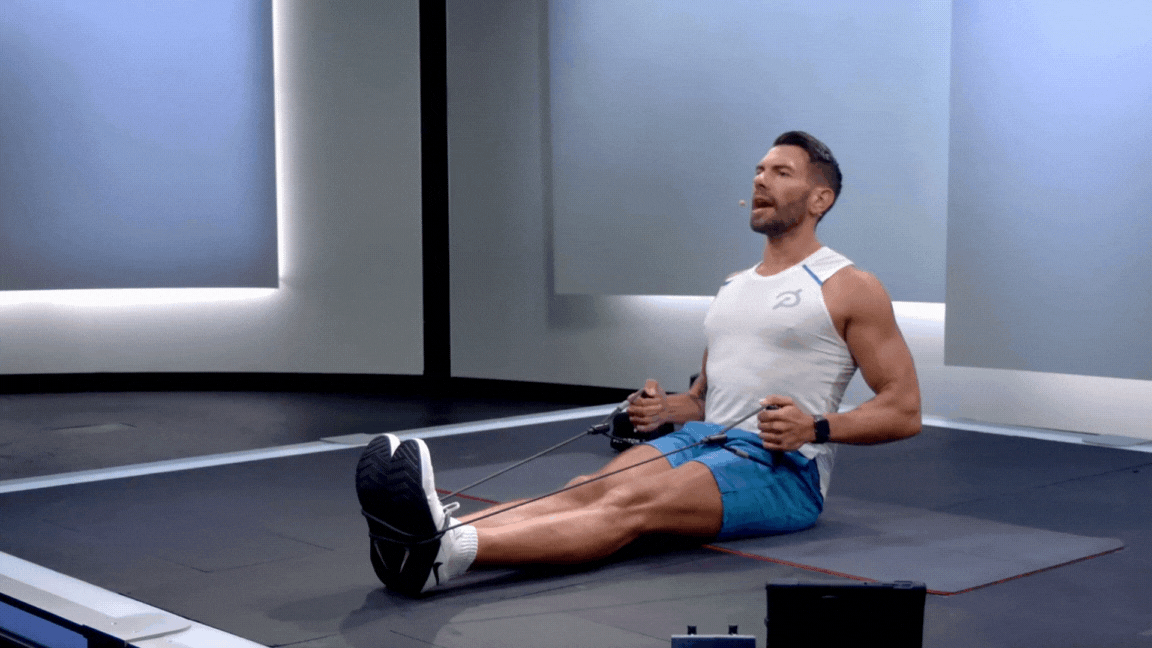
1. Seated Resistance Band Row
1. Sit on the floor with both of your feet out in front of you. Wrap the resistance band securely around both of your feet and grab the resistance band handles in each hand.
2. Keeping your back straight, shoulders back, core engaged, and the head and chest up, pull your arms back, squeezing the shoulder blades together.
3. Slowly extend the arms back out, releasing the tension in the band with control, allowing your elbows to straighten to return to the starting position.
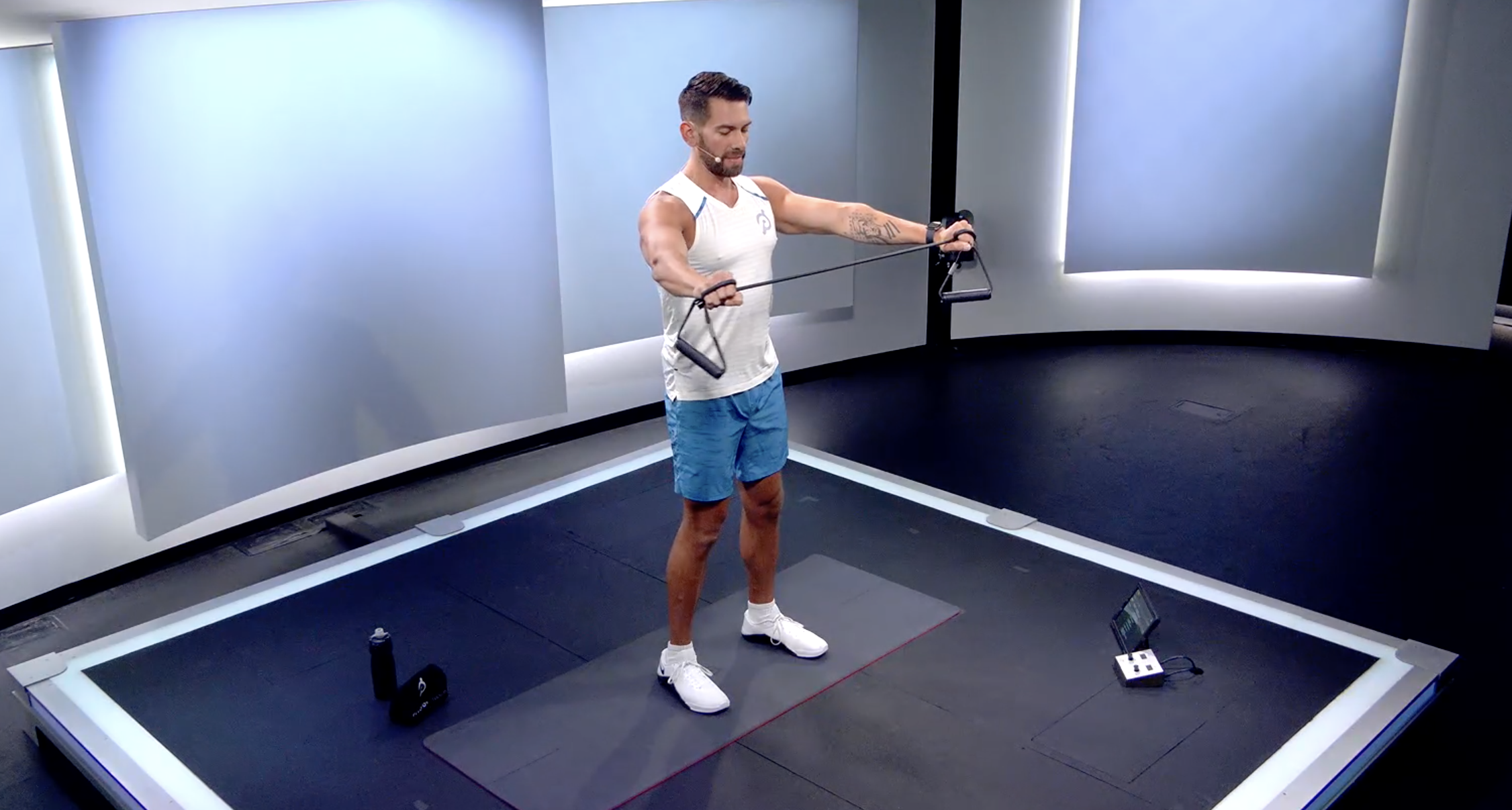
2. Resistance Band Pull-Apart
1. Start standing with your arms extended straight out in front of your chest, holding onto the band with each hand, palms facing down.
2. Extend your arms out to your sides, pulling on the band to create tension.
3. Bring your arms back in front of your chest with control, releasing the tension in the band to return to start.
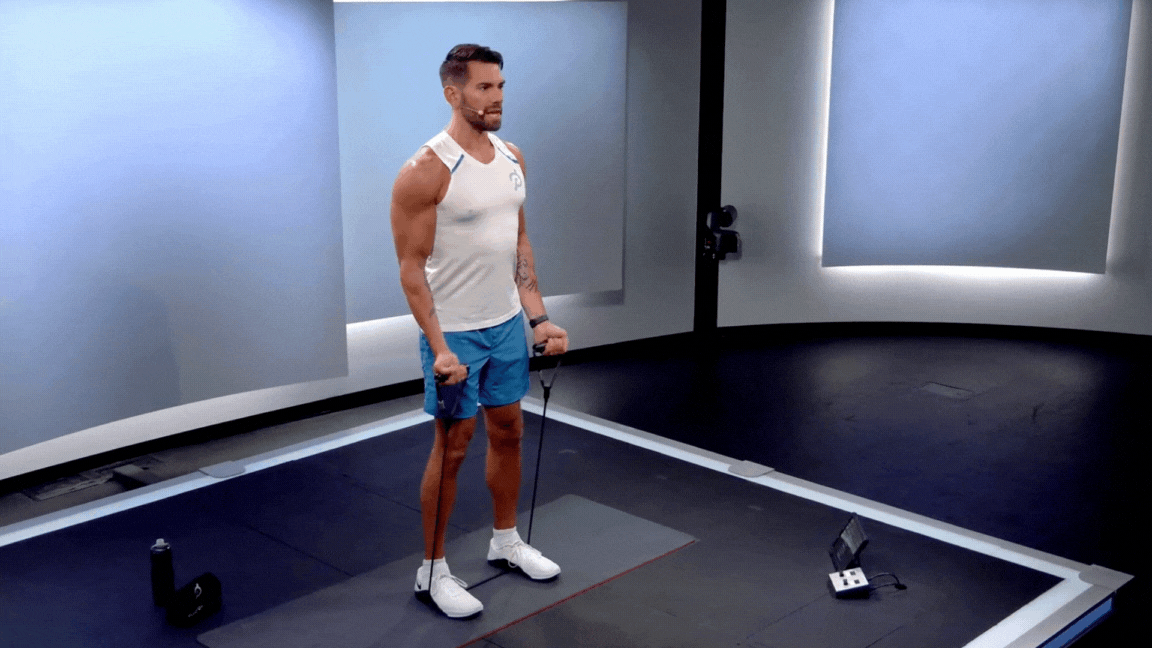
3. Biceps Curl
1. Stand on the resistance band, grasping the band with your palms facing forward and your arms resting at your sides.
2. Contract your biceps to pull the band toward your shoulders while allowing your elbows to bend to create tension in the band.
3. Lower the band and straighten your elbows with control to return to start.
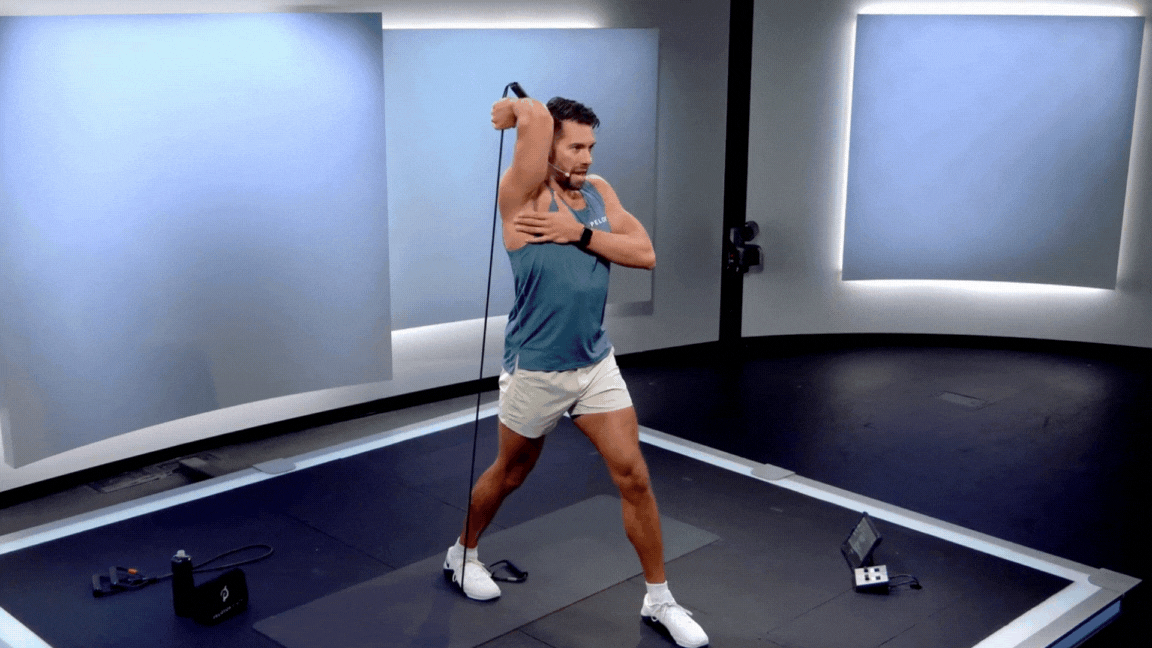
4. Single Arm Triceps Extension
1. Place one handle of the resistance band on the floor. Step at the base of the handle (on the rubber part of the band) with your right foot. Send the left foot forward so you're in a split stance position.
2. Grab the base of the other end of the handle with your right hand, and bring it up over your head, bicep by the ear, elbow pointing forward.
3. Keeping the shoulders square, bend the arm back while keeping the elbow still and pointed forward to work the tricep.
5. Resistance Band Pull-Down
1. Anchor the resistance band above your head to a sturdy object. Standing with a slight bend in your knees and slight forward lean, hold the band in each hand with your arms extended diagonally above your head.
2. Keeping your back and elbows straight and your core engaged, lower your arms to your sides, creating tension in the band.
3. Raise your arms until they’re extended diagonally above your head, releasing tension in the band with control to return to start.
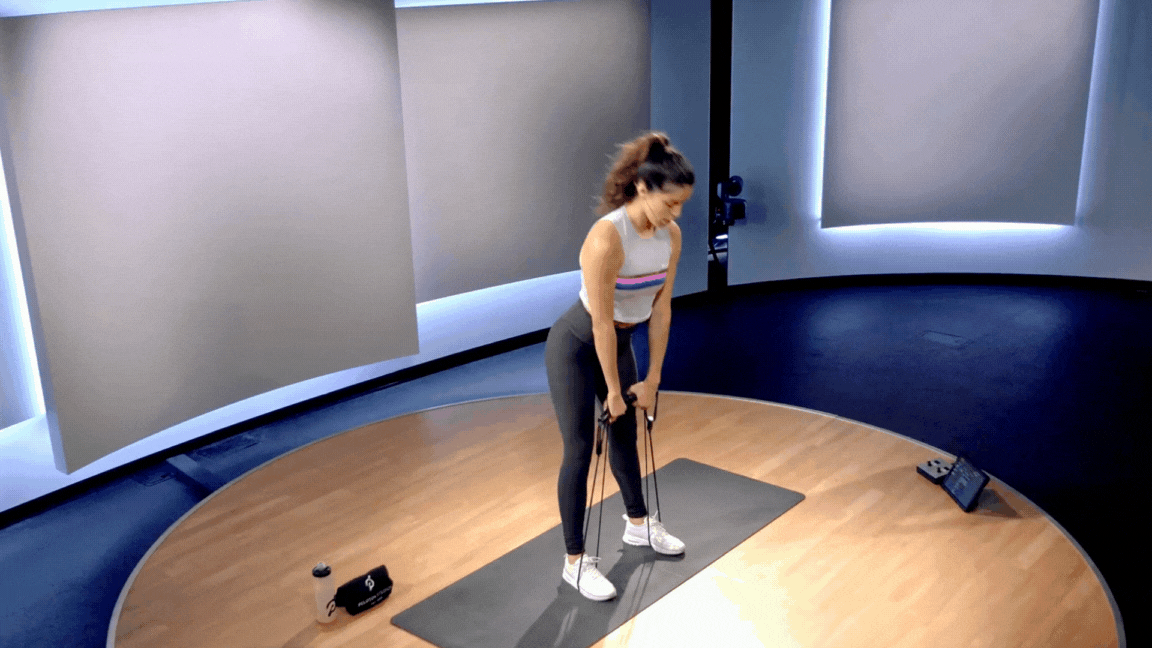
6. Resistance Band Deadlift
1. Stand the resistance band with both of your feet about hip-width apart. Send your hips backward while allowing your knees to bend and your torso to lean forward. Grab onto the resistance band with both hands.
2. Maintaining a straight back and engaged core, squeeze your glutes and push through your heels to drive hips forward, allowing your knees to straighten and creating tension in the band.
3. Keeping your back straight and core engaged, send your hips backward while allowing your knees to bend and your torso to lean forward to release tension in the band and return to start.
How to Incorporate Upper Body Resistance Band Workouts Into Your Routine
Some people opt to use resistance bands strictly for warm-ups or when recovering from an injury, while others rely on bands during the main portion of their workouts. You can use resistance bands as your only piece of equipment during a workout, or as an add-on.
When shopping for resistance bands, you’ll notice variations in design. Options include “mini” resistance bands which form small loops, longer loop bands, or open-ended resistance bands, including bands made with elastic or fabric.
For some exercises, it’s possible to adjust a band’s resistance level when setting up for the movement. For example, the less slack you allow in a band between your hands when preparing for band pull aparts, the more difficult the exercise will be.
For more resistance band workout ideas, Peloton has a selection of Resistance Band Classes that you can follow along with, including upper body-focused sessions. Whether you’re taking a class, fitting in a workout while traveling, or warming up for a strength training session, resistance bands can help you target your arms, back, and shoulder muscles effectively.
This content is for informational and educational purposes only and does not constitute individualized advice. It is not intended to replace professional medical evaluation, diagnosis, or treatment. Seek the advice of your physician for questions you may have regarding your health or a medical condition. If you are having a medical emergency, call your physician or 911 immediately.
Level up your inbox.
Subscribe for a weekly dose of fitness, plus the latest promos, launches, and events.
By providing your email address, you agree to receive marketing communications from Peloton.
For more about how we use your information, see our Privacy Policy.








